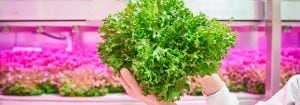Be the first! Get the latest news and updates - Subscribe to our newsletter!
Did you know that a vertical farm can mimic nature?
The number one mission for a vertical farm that is growing plants indoors, is to mimic nature so they can grow the freshest and tastiest crops anywhere.
Every grower knows how hard it is to understand nature when growing a certain crop in a certain place. That’s because plants come from very different climates and growing conditions across the globe. Some of the plants we eat flourish in the moisture and heat of the tropics, others in arid deserts or on steep mountain slopes. Some plants can acclimate on their own or be bred into new varieties that can grow in a different climate. But it’s a whole new situation when you are growing plants indoors in climate-controlled conditions in a city farm or vertical farm.

In a vertical farm, we can provide the plants we are growing with a climate very similar to the original climate they are designed to grow in. For example, spinach likes it cold, especially at the start of their growth cycle, and we can set up the climate to provide that. In contrast, basil likes it warm because it is a tropical plant. Some species grow best at a temperature of around 28 °C. Some plants like a long night’s sleep, while others grow well under a long day of illumination. Each crop has its own climate requirements and limits.
Creating the ideal climate doesn’t always mean selecting what’s good for the plant; sometimes it’s about what’s good for the consumer. For example, growing red oak lettuce in a climate and under LED grow light settings that are good for the plant’s development will not necessarily result in the deep red-colored lettuce that comes from growing it outside. In an open field, the red oak lettuce encounters various environmental changes that are interpreted as “stress factors,” like UV radiation or large temperature changes. These factors make the lettuce produce a protective pigment (anthocyanin) that gives the lettuce its red coloration.
This “stress” is neither good nor bad for the plant, it is just the way the plant is designed to survive through different climatic changes in nature. In this case, the plant’s coping mechanism is good for the consumer, who is used to seeing a red pigmented lettuce and would not accept a red oak variety of lettuce that is green, for instance. And it is supposed to be healthy, too.
In a vertical farm we can create the specific climate and lighting conditions that mimic the natural environment a crop is grown in to get the best results. In the case of the red oak lettuce, we can even simulate the environmental changes it undergoes to trigger the plant to produce the characteristic photo protective pigments it is known for.

The same variety of red oak lettuce being grown indoors using various Philips light recipes.
We call the settings for these climate and lighting conditions, a growth recipe. Our goal with the growth recipes we create for LED grow lights is to provide the right conditions to cultivate crops that meet each grower’s requirements. In some cases, it means getting a product that has the same look and taste that a consumer expects. In other cases, it means experimenting with crops that look and taste different than normal. We always aim to grow a top-quality crop that tastes as good as one grown in the summer. That can be challenging if you are growing leafy greens in extremely cold areas, for example, but even then we can use LED grow lights to get “as good as summer” results.

At the Philips GrowWise Research Centre, our experts study the conditions needed to optimise plant growth. This includes the effect that different types of vertical farming lighting, climate systems, nutrition, irrigation, sensors and data collection can have on plant health and quality. It enables us to develop growth recipes for vertical farmers that will produce specific characteristics and create healthier plants with higher yields.
For additional information about this topic, please contact Jarno Mooren at jarno.mooren@signify.com.
Related articles
Contact us
Contact certified partners
Philips products are sold through a global network of certified partners. Find partners in your region for more information about Philips LED grow lights.
Contact Philips
What are the best LED grow lights for your situation? We are here to help. Please use our form to submit your request.
Subscribe to newsletter
Keep up to date about Philips LED lighting in horticulture by subscribing to our newsletter.
Join our team
Interested in discovering your recipe for growth and joining our team? Take a look at our career page for more information.
Interested?
Learn more about LED lighting in horticulture by reading our latest articles and case studies.



